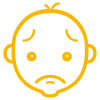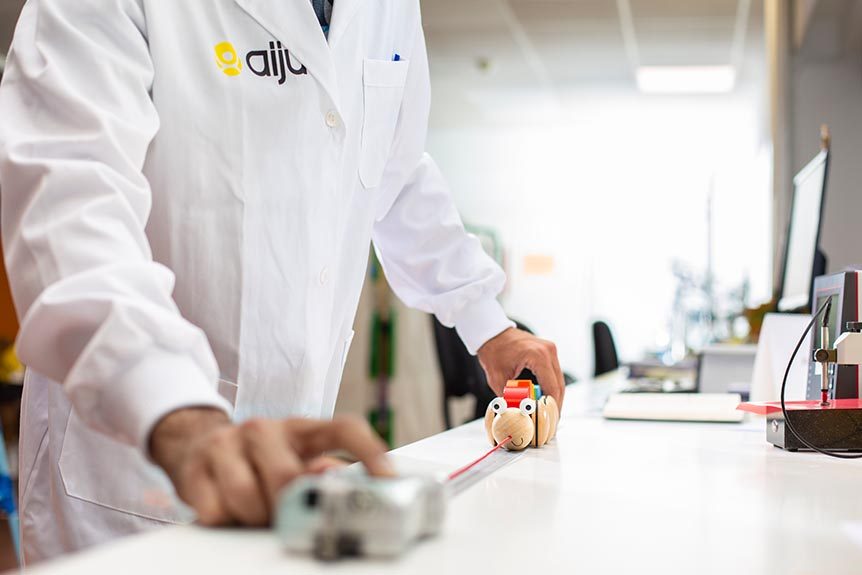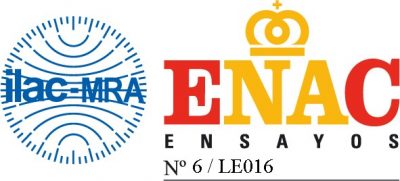Tests according to European toy safety standards
Directive 2009/48/EC on toy safety, the European legislative framework for toys, requires that these products do not compromise the health of users and that they meet a number of specific requirements. Technical standards are tools that assist in the assessment of these requirements.
AIJU offers testing services in accordance with European toy safety standards endorsed by its internationally recognised laboratory. See the scope of our accreditation here.

Services related to toy testing according to European standards
Toy safety
This standard establishes a series of mechanical and constructive requirements that are of general application to all toys, such as those regulating the presence of sharp edges, sharp points, toys with projectiles, magnets, or even the acoustic behaviour of toys that emit a sound, among others. For toys specifically designed for children under 36 months, the standard defines specific additional requirements that seek to reduce the risks that this type of toy may present, such as the presence of small pieces and beads, rattle ropes, teething toys, hemispherical toys, etc. It also includes further requirements for the items that form part of their packaging, including the markings, labelling and instructions that must be included in toys.
This specifies certain flammable materials that are prohibited in the manufacture of all toys, and requirements concerning the flammability of certain toys (e.g. beards, wigs, masks, fancy dress, toys into which a child can penetrate, stuffed flexible toys, etc.), when they are subjected to a small source of ignition.
This establishes requirements and test methods for the migration of Al, Sb, As, Ba, B, Cd, Cr (III) and Cr (VI), Co, Cu, Pb, Mn, Hg, Ni, Se, Sr, Sn, Organic Sn and Zn in toy materials (paints, varnishes, lacquers, printing inks, modelling materials, graphite materials in pencils, liquid ink in pens, metallic materials, polymeric materials, paper and cardboard, fabrics, wood, etc.) that are susceptible to being sucked, bitten or ingested by the child.
This specifies the requirements concerning the maximum amount of certain substances and preparations used in experimental sets for chemistry and related activities. The standard applies to chemistry sets and complementary games. The standard contains specific requirements for toys that generate carbon dioxide and crystal growing kits. It also applies to experimental sets within the fields of mineralogy, biology, physics, microscopy and environmental sciences, when they contain one or more chemical substance and/or preparation. It also specifies requirements concerning marking, list of contents, instructions for use and the materials used in the experiments.
This standard applies to sets such as plaster of Paris (gypsum) moulding sets, ceramic and vitreous enamelling materials supplied in miniature workshop sets, oven-hardening plasticised PVC modelling clay sets, plastic moulding sets, embedding sets and adhesives, paints, lacquers, varnishes, thinners and cleaning agents (solvents) supplied or recommended in model sets. It specifies the maximum quantities of the substances and preparations that can be supplied with the toy, as well as marking requirements, warnings, safety rules, list of contents, instructions for use and first aid information.
This sets requirements for substances and materials used in finger paints, and applies only to finger paints. Additional requirements are also specified for their marking and labelling, and for their containers.
This part of Standard EN 71 includes requirements and test methods for activity toys for domestic use, often attached to or incorporating a crossbeam, and similar toys intended for children under 14 years of age to play on or in, and to support the weight of one child or several children. The object and field of application of this standard excludes equipment intended for use in schools, kindergartens, public playgrounds, restaurants, shopping centres and similar public places; this is dealt with in EN 1176 Parts 1 to 6, 10 and 11.
These parts of the standard specify the requirements for the migration or content of certain hazardous organic chemicals contained in the materials of certain toys, and describe the sample preparation methods and test methods used to determine these compounds. The routes of exposure taken into consideration are: mouth contact, ingestion, skin contact, eye contact and inhalation. The organic compounds taken into consideration are certain solvents, preservatives, plasticizers, flame retardants, monomers, biocides, processing aids and colouring agents.
This standard sets out the requirements and test methods for determining free nitrosamines and nitrosatable compounds from elastomeric toys and toy parts intended for children under the age of 3, elastomeric toys and toy parts intended to be placed in the mouth and finger paints.
The standard applies to board games that involve smelling or tasting, cosmetic kits and complementary sets, and it specifies requirements regarding the use of substances and mixtures and in some cases, their quantity. The standard also includes requirements regarding labelling, the instructions that must be provided, safety rules and first aid.
This standard sets out the requirements to be met by trampolines for domestic use, as well as their access devices and their enclosures, used by a single person either indoors and/or outdoors. It also sets out the test methods for verifying compliance with the requirements.
- Evaluation of the suitability of fragrances in toys
- Evaluation of the labelling and composition of toy cosmetics
- Toy safety tests according to European Standard EN-71 (Parts 1- 14):
Organic compounds:
- Additives: phthalates, preservatives, antioxidants, etc.
- Unintentionally added substances: Amines, PAHs, etc.
- Volatile substances: Benzene, Toluene, etc.
- Azo dyes.
- Organotin compounds
- Formaldehyde
- Bisphenol A
- Other substances restricted by the REACH regulation and the RoHS Directive
Safety of electric toys
- Safety testing of electric toys. Safety test according to European standard EN62115. This standard establishes the safety conditions to be met by electric toys supplied with very low safety voltage, whether alternating current or direct current, intended for use inside buildings or outdoors. Electric toys must also comply with the requirements of Directive 2004/108/EC on electromagnetic compatibility.
- Determination of restricted substances in accordance with the RoHS Directive. Directive 2011/65/EU restricts certain hazardous substances in electrical and electronic equipment (lead, mercury, cadmium, chromium VI, PBB, PBDE and phthalates).
- Labelling reviews:
- Marking of electrical and electronic devices in accordance with directive 2012/19/EU on waste electrical and electronic equipment (WEEE).
- Portable luminaires for children according to EN 60598-2-10 Particular requirements. Portable luminaires for children.
- Battery chargers according to EN 60335-2-29. Particular requirements for battery chargers, and EN 60335-2-29 annex AA, battery chargers for use by children.
- Transformers for toys according to EN 61558-2-7. Particular requirements and tests for transformers and linear power supply units for linear toys.
- Transformers for toys according to EN 61558-2-16. Particular requirements and tests for transformers and switch mode power supply units for toys.
Benefits of testing toys with European standards
By working with AIJU you can:




How we do it




Our experience in testing toys with European standards
AIJU owns the first laboratory to be accredited by the ENAC (National Accreditation Entity) according to ISO/IEC 17025 to carry out tests on toys (accreditation nº 6/LE016).
- Confidentiality guaranteed.
- A track record going back more than 30 years.
- Guarantee of knowledge updated with European criteria.
- Overview of the toy value chain
